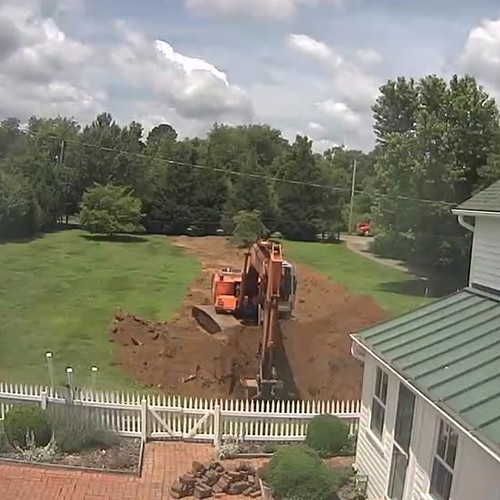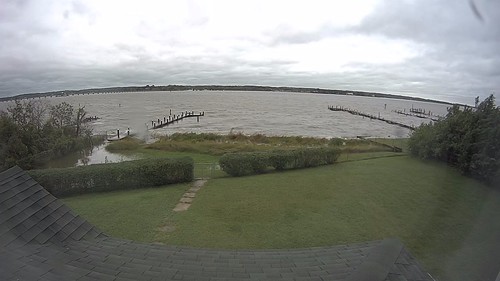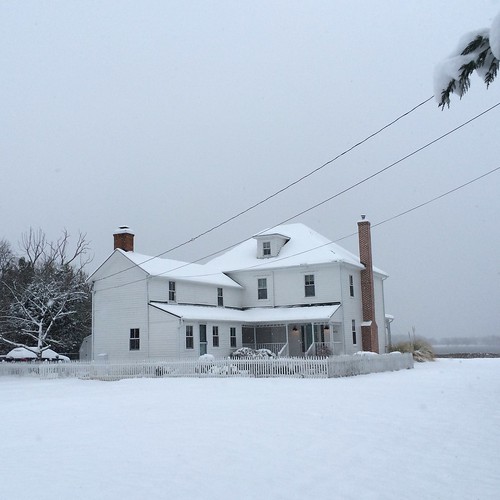This week marks the one year anniversary of the most significant home damage event we've ever experienced.
Yes, one year has passed since our four square, in the midst of the coldest week in the DC area in over 100 years, had a boiler failure and a subsequent whole home freeze.
The resulting damage destroyed our home's oil fired boiler...
...ruptured plumbing lines throughout the house...
...burst baseboard radiators and copper radiator lines in every single room...
...broke all three toilets...
...destroyed several plumbing fixtures...
...and effectively rendered our house an almost uninhabitable shell for many months while leaving us angry, frustrated, and very cold.
The subsequent project to repair and replace the house's HVAC and plumbing stretched on for months, required far more effort than we anticipated at the onset, and tried our patience at every turn as we discovered obstacle after obstacle.
But now that we once again have fully working plumbing (with toilets that flush and refill automatically like fancy people), functional forced air heating for the winter, and air conditioning for the summer, I wanted to take a moment to look at where we are today and compare it to where we were a year ago. More specifically, I want to look at how we're now better suited to prevent such an issue in the future. After all, one of the most frequent questions we receive from friends, family, and pretty much anyone who learned of the "big freeze" is the same, "So...how is your house doing now? Is it all fixed?"
Where We Were
When this all began last year our home was heated by an outdated and oversized oil fired boiler fueled by a large 500 gallon underground oil tank. Though the heat it produced was very comfortable, the boiler was loud, inefficient, and expensive to operate. Though oil prices have dropped since last year, it was costing the previous owners about $1,500-$2,000 to fill the tank, and we'd typically need two fills per year. Expensive or not, it was what we had, and it seemed to be working well. I had dreams of turning the baseboard radiators into radiant heat, but we were content with the boiler.
The house also didn't have central air (and no duct work), so it was cooled by window units in the summer, which also carried a hefty price tag for electricity. Let's not forget how the window units allowed hundreds of stink bugs to infiltrate the house and just generally looked bad from both inside and out.
And one of the most aesthetically unappealing (to me) aspects of our home is all of the boxed in or exposed plumbing lines. All of the plumbing was added to the house well after it was built, so it was run along baseboards and boxed in up the corners of walls. I knew we'd eventually address the exposed pipes, but I didn't realize it would end up being one of our first giant projects.
Where Are We Now?
After a spring and summer full of contacting our insurance, our mortgage company, coordinating repair estimates, the claims process, determining what the new system should be, and a summer full of a whole lot of work, we are the proud owners of a shiny and new geothermal heat pump and fully concealed plumbing.

Digging up the front yard for the geothermal pipe
For those not familiar with geothermal, it simply means that our heating and cooling come from the ground, rather than through burning a fuel (like oil or gas) or using an electric element to heat, or using a condensing unit to cool. This equates to a heating and cooling system that's far more efficient and environmentally friendly, only using electricity to run the pumps and letting the ground work as a large heat sink that stays warm in the winter for heat, and cool in the summer for air conditioning.

Duct work waiting to go under the house
With all of our modern and efficient systems in place, we should be sitting pretty, right? Well, yes and no. There is still a risk that something like what happened to us last year could happen again. After all, we're not at this house 100% of the time, so if the power goes out, or something else happens that impacts the temperature of the house, we could very well be back to square one.

Geothermal system in the middle of install. It isn't small...
The main thing we've wanted to do is to install various remote monitoring resources that will help us be aware of the status of our house, even if we're not there. This is critical in keeping us informed about the house's general well being, since last year we walked into a completely frozen house and had no idea of the situation until we could still see our breath while standing in front of the failed boiler. If we had known the boiler had failed and the temperature of the house was falling, there's a chance we could have gotten out there fast enough to fixed the problem before it turned into one giant icicle. But the question is, what sort of remote monitoring is necessary?
Here's our suite of tools we use to enable us to remotely view and control our house in the hopes this will prevent a repeat of the freeze of 2015.
WaterFurnace Symphony Thermostat
In my opinion, the most critical element for the remote monitoring our house's temperature is simple. It's the ability to access our primary HVAC thermostat using the Internet (or our phone, as it more typically goes). This will allow us to not only determine and control the set temperature for the heating and cooling, but will also allow us to remotely monitor the current indoor temperature.
In our case, in order to get the most our of our new geothermal heating system, we chose the companion wifi enabled thermostat offering from WaterFurnace (the manufacturer of our HVAC system) call the Symphony.
The Symphony is a relatively new option and very specific to the system we had installed. While the Nest and other smart thermostats may have claimed to "work" with the geothermal, we'd lose a lot of the benefits of the system if we had installed one. The off the shelf smart thermostats are generic to HVAC systems, and the Symphony has been specifically programmed to work with the unique elements of a WaterFurnace Series 5 geothermal heat pump we installed, such as managing the variable speed of the system's fan. It also offers a bunch of other really nice features, like the ability to measure the real time energy usage of the system components, as well as the incoming and outgoing air and water temperatures.
Back in October our HVAC contractor, Southern Pride Service, came out to install the Symphony add-on and I stuck close by to learn about the process. Since the symphony is an add-on to the existing system and standard WaterFurnace thermostat, this install was pretty straight forward and only required a tech with some specific equipment to configure the whole thing.
Overall the install was probably only about an hour total, and simply required that we mount the communication device in our utility room connected to the main WaterFurnace unit.
Once we had it hooked up to the system, we had to configure the device to recognize our wifi connection, set up an account on the WaterFurnace website, and download the app on my phone, then we were off to the races.
We were immediately able to see the status of the system, energy usage, etc.
I immediately breathed a sigh of relief as it meant we were one step closer to being able to truly monitor the status of our house while we weren't there. But the only thing the Symphony doesn't have yet is an open API that would allow people (like me) to code things to work with the system. I'd love to integrate If This Then That (IFTTT) with a recipe that would automatically adjust the temperature when my phone/car knows we're driving out to the house. Maybe sometime soon.
We can also use this app to help diagnose issues with the HVAC while we're not there. For example, when our power went out at the house and came back on, I opened the app to check on the temperature. But when the app opened this is what I saw.
This could mean that either the Internet was still down, or the HVAC unit doesn't have power and isn't running. So I checked on one of our cameras and could access it, which told me the Internet was alive. Based on this I was able to contact our HVAC company who paid a visit to the house and was able to fix the issue with the HVAC unit. This all happened remotely and we didn't have to be on site to identify that there was an issue or coordinate fixing it. In this case the thermostat package and app saved our house from a repeat freeze.
Samsung SmartCam Video Monitoring
The funny thing about monitoring temperature data is that it only goes so far to making me feel good about the state of our house. There's something very assuring about actually seeing that things are okay. This is why we have several of my favorite Samsung SmartCam video cameras set up throughout the house. These camera let us keep an eye on everything from the water around our pier...

Keeping an eye on high tide even though we were in Ireland
...to the crawlspace below the HVAC equipment.
I figure if we have a leak in the house the first place it's going to start filling up is in the crawl space, so I'd like to have eyes on that if it's an actual issue.
These cameras have been great and I still love them. They recently released the HD Plus that looks far more like the Dropcam than the previous version. I bought one just about a month ago and it's the camera in the crawlspace from the photo above.
Samsung updated the firmware a few months ago and it disabled the local web server on the cameras. There's been a bit of an outcry from the people that bought these cameras to use in this way, but I think samsung disabled it because of the websites that were connecting to unprotected cameras all over the internet and displaying people's lives without their knowledge. At any rate, they still work great for us and for our purposes, and you can even use them to live stream to YouTube if you'd like.
We were even able to capture this amazing rainbow last April. So the camera is also good at making you wish you were there.
Alarm.com and 2Gig Alarm Monitoring
The main weakness with all of this monitoring is that it requires both the power to be on and the Internet to be up and running to function. Without both power and internet, we have no idea if the house is even there, and that's sort of a strange thought (the whole if a tree falls in the forest thing). Also, if the internet goes down and we only had the thermostat and video monitoring, we have no good way of knowing if the power is still on and only the Internet is down, or if the whole thing is offline.
This is where our security system comes into the mix. The system we chose is the 2Gig DIY install system (you can read more about it on our series regarding its install), and it is a cellular based system with a battery backup. This means that when the Internet goes down and we can't access the camera or thermostat, we can remotely check on our alarm system to see if we can reach it. If we're able to reach the alarm system and there are no errors, I typically start troubleshooting the Internet and possibly remote restarting the cable modem from the Xfinity website.
But if we lose power to the house (which is the real risk of freezing since HVAC will also be off), the alarm system will stay online due to its battery backup, but Alarm.com will also send us a message on our phone and an email letting us know that power was lost to the house. Not only will it alert us, it will also let us know what percentage of customers locally also lost power, so we can understand if it's a localized thing or something affecting many different people throughout the area.
We had this very situation during the blizzard a few weeks ago. When we received the notification that our house had lost power we were able to go on our power company's website to see the status of outages in the area. We were also able to report a failure in our house and sign up for text notifications for updates on the ETA to restore power. With all of these systems working the way they do, we do truly live in an amazingly connected world.
And finally, we added several smoke detectors to the house that are also freeze detectors. If the temperature around these devices starts to get into the danger zone of cold where a freeze could happen, the system will notify us of the issue and the fact that we need to get out to the house and take care of the issues.
Remote Temperature Monitoring
And finally, aside from all of the other items, one thing I want to keep an eye on simply for peace of mind is the the temperature in the crawl space. More importantly, I want to watch the temperature in the crawl space near where the water line comes into the house. I'm now completely paranoid that no matter how we pay attention to the house, the systems, the HVAC, the temperature, etc, that our water line is going to freeze while we're away and rupture. This is why I have one of the cameras in the crawlspace pointing back at the main HVAC trunk.
I realize this is all pretty much my own paranoia, but I'd rather calm my nerves by having a simple device that keeps track of the current temperature and humidity. Is that so wrong? So I went ahead and bought one of these models from AcuRite.
The cool thing about this thermometer is that it's expandable and I can add devices over time. This means we'll be able to use is to see both indoor and outdoor temperature information and can even use it to track trend information over time. This makes my nerd heart truly smile, and may help us plan for and execute a nice vegetable garden if we ever get to that point.
So there you have it. These three items together give us remote insight into the current status of our house. They help us identify problems before they become big problems, calm our nerves, and give us a bit of peace of mind.
Just this week we had another situation where the various devices proved extremely useful. It seemed I failed to properly lock and latch one of our French doors when we left last weekend. On Tuesday morning we had a pretty good storm kicking up and a gust of wind was able to blow the door open. Due to our security system we received a call that a door had been opened and the alarm was activated. We checked on the cameras in the house and various other security sensors, so we could see that nobody was actually in the house, so either the door sensor had malfunctioned, or I was a doofus and hadn't properly closed the door. By opening the thermostat app we could see that the temperature on the first floor of the house was falling pretty quickly, so it was likely the door was actually open. It was a huge pain to have to drive out to the house when we weren't planning to go (at the crack of dawn before our work day started), but when we got there this is what welcomed us.
The water was really rough and the wind was whipping, so it's no surprise that it blew an incorrectly latched door open.
Though it was a pain, we were fortunate to have the house configured to let us know when something like this happened. If we hadn't have been notified, or didn't have a way to figure this out, that door could have remained open until the next time we made it out to the house.
The two lessons I learned are: 1) you can't be too prepared with monitoring; and 2) learn how to lock the door properly.
The end result is that we're in a much better place to proactively monitor our home and react when there's an issue. Last year's big freeze was certainly unfortunate to put it mildly, but we were able to learn a lot from the experience and are now better prepared to prevent something similar from happening again in the future.
Do you have anything in your home that allows you to remotely monitor everything? I'd love to hear about anything we might be missing that we can add to our bag of tricks. There's almost nothing I like more than a well connected home, so I'm all ears.

![]()
![]()